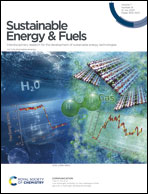An ultrahigh energy density Mg–air battery with organic acid–solid anolyte biphasic electrolytes†
Abstract
The magnesium–air (Mg–air) battery is a promising electrochemical system with high theoretical energy density, inherent safety, and low cost. However, its commercialization is not proceeding as expected, mainly due to the low anode utilization efficiency resulting from the serious hydrogen evolution corrosion, as well as the low operating voltage in conventional NaCl aqueous electrolyte. Herein, we designed acetic acid–sodium alginate (SA)/NaCl solid anolyte biphasic electrolytes to broaden the voltage window and alleviate the anode corrosion. Meanwhile, the prepared SA/NaCl solid electrolyte has a strong ability to complex generated Mg2+ ions while releasing Na+ ions during discharge, enabling its high ionic conductivity. Encouragingly, the anode utilization efficiency increased from 9.6% (10 wt% NaCl aqueous solution electrolyte) to 61.5% at 0.1 mA cm−2. The assembled Mg–air battery delivers a high open circuit potential (OCP) of 2.59 V and an average discharge voltage of 2.01 V at 0.5 mA cm−2, and a gratifying high anode energy density of 2984.5 W h kg−1 is achieved.



 Please wait while we load your content...
Please wait while we load your content...